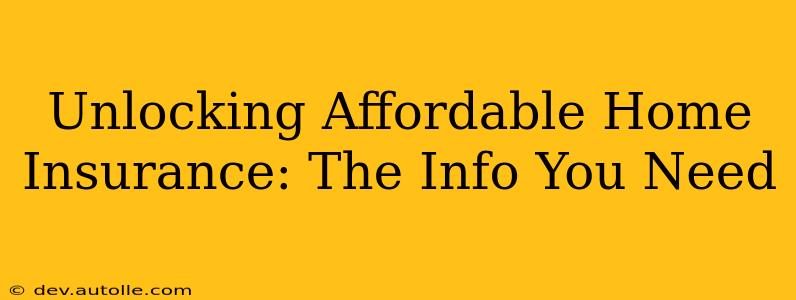Finding affordable home insurance can feel like navigating a maze. Premiums vary wildly, and understanding the factors influencing cost is crucial. This comprehensive guide will help you unlock savings and secure the coverage you need without breaking the bank. We'll delve into strategies for lowering your premiums, exploring different types of policies and answering common questions to empower you to make informed decisions.
What Factors Influence Home Insurance Costs?
Several factors significantly impact your home insurance premiums. Understanding these helps you target areas for potential savings. These include:
- Location: Areas prone to natural disasters (hurricanes, earthquakes, wildfires) generally command higher premiums due to increased risk. Your specific neighborhood's crime rate also plays a role.
- Home Value: The higher the value of your home, the more expensive the insurance will be, as the insurer is covering a larger potential loss.
- Coverage Amount and Type: Comprehensive policies covering a wider range of risks naturally cost more than basic policies. Higher deductibles (the amount you pay out-of-pocket before insurance kicks in) lower premiums but increase your risk.
- Age and Condition of Your Home: Older homes might require more extensive repairs, influencing premium costs. Proper maintenance and updates can help lower premiums.
- Credit Score: Surprisingly, your credit score often factors into your insurance rates. A higher credit score usually translates to lower premiums.
- Security Features: Installing security systems, such as alarm systems or security cameras, can significantly reduce your premiums. These features demonstrate a lower risk to the insurer.
How Can I Find the Cheapest Home Insurance?
Finding the cheapest home insurance involves proactive steps and smart choices. Here’s how:
- Shop Around and Compare Quotes: Don't settle for the first quote you receive. Get quotes from multiple insurers to compare coverage and pricing. Online comparison tools can streamline this process.
- Bundle Your Policies: Many insurers offer discounts when you bundle home and auto insurance. This often represents significant savings.
- Increase Your Deductible: Raising your deductible increases your out-of-pocket expense in case of a claim, but it significantly reduces your premiums. Weigh the risk versus reward carefully.
- Improve Your Home Security: As mentioned earlier, security measures like alarm systems and deadbolt locks can lower your premiums.
- Maintain Your Home: Regular maintenance reduces the risk of damage and claims, ultimately impacting your insurance costs.
- Review Your Coverage Annually: Your needs and risk profile may change over time. Review your coverage annually to ensure you have adequate protection without paying for unnecessary coverage.
What is the Difference Between HO-3 and HO-5 Homeowner's Insurance?
HO-3 and HO-5 policies are both comprehensive, but they differ in how they cover your belongings.
- HO-3 (Special Form): This is the most common type of homeowner's insurance. It covers your home and belongings against most perils (causes of loss) except those specifically excluded in the policy. Coverage for personal property is "open perils" meaning it covers all risks except what's specifically excluded.
- HO-5 (Comprehensive Form): This offers broader coverage than an HO-3. It covers both your home and belongings on an "open perils" basis. This means virtually anything that damages your property is covered unless specifically excluded. It offers more comprehensive protection but typically costs more.
Choosing between HO-3 and HO-5 depends on your risk tolerance and budget. An HO-3 provides excellent protection for most homeowners at a more affordable price.
What is a Homeowners Insurance Deductible?
Your homeowner's insurance deductible is the amount you're responsible for paying out-of-pocket before your insurance coverage kicks in. For example, if your deductible is $1,000 and you have $5,000 in damages, you pay $1,000, and your insurer pays $4,000.
A higher deductible lowers your premiums, while a lower deductible increases them. Choosing the right deductible depends on your financial situation and risk tolerance.
What Does Homeowners Insurance Typically Cover?
Homeowner's insurance typically covers:
- Damage to your home's structure: This covers damage from fire, wind, hail, and other covered perils.
- Damage to your personal belongings: This protects your furniture, clothing, electronics, and other possessions.
- Liability protection: This covers legal costs and medical expenses if someone is injured on your property.
- Additional living expenses: This covers temporary housing costs if your home is uninhabitable due to a covered loss.
Understanding your policy's specifics is crucial. Always review your policy documents carefully to fully grasp what's covered.
Can I Lower My Home Insurance Premiums After I Buy a Home?
Yes, even after purchasing your home, you can take steps to lower your premiums. This includes implementing home improvements (security upgrades, roof replacement), maintaining your property meticulously, and shopping around for better rates.
By understanding the factors that influence home insurance costs and employing the strategies outlined above, you can significantly reduce your premiums and secure affordable home insurance that meets your needs. Remember to always compare quotes and carefully review policy details before making a decision.

